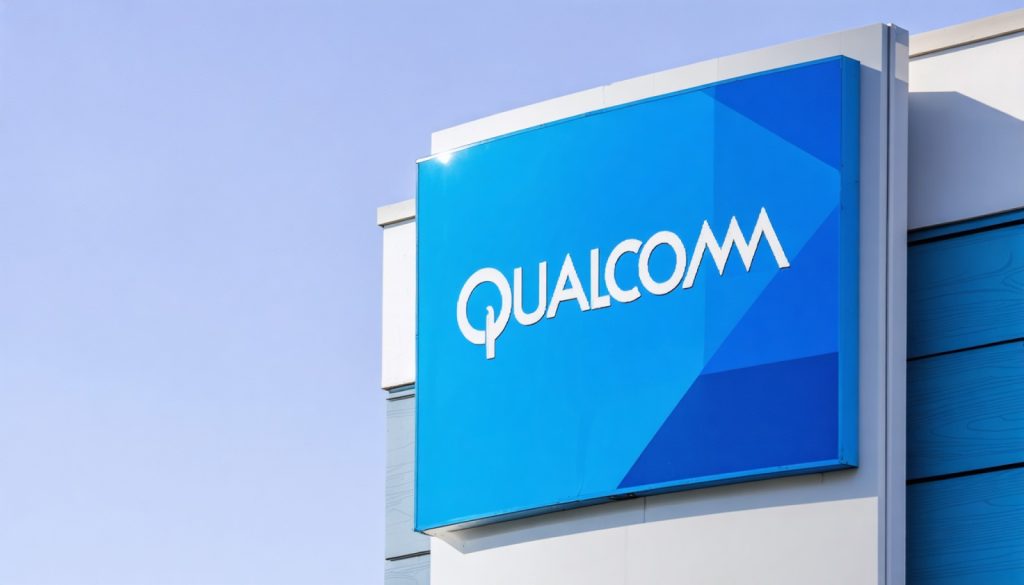
- Qualcomm is cautiously optimistic amidst global trade tensions and potential impacts from U.S. tariffs.
- Revenue projections for fiscal Q3 2025 are between $9.9 billion and $10.7 billion, slightly below analyst expectations.
- Qualcomm’s global supply chain shields it from direct tariff effects, though potential smartphone demand slowdown is a concern.
- The competition in China’s smartphone market remains intense, with Qualcomm and MediaTek battling for market share.
- Recent financial highlights include a 12% rise in handset revenue, a 59% jump in automotive chips, and a 17% increase in IoT revenue.
- Qualcomm’s total revenue reached $10.9 billion, with net income of $2.8 billion, surpassing predictions.
- The company’s strategic foresight and diversity in products serve as a strong defense against economic challenges.
As the global arena of trade tensions simmers, all eyes are on Qualcomm, the semiconductor giant navigating the stormy waters of tariffs and smartphone sales. Recent fiscal forecasts have painted a picture of cautious optimism, with Qualcomm bracing for potential impacts from U.S. President Donald Trump’s reciprocal tariffs. The company’s revenue projections for the third quarter of fiscal 2025 dip slightly below analyst expectations, predicting earnings between $9.9 billion and $10.7 billion, hinting at the unseen undercurrents in the market.
Despite the economic turbulence created by tariff strategies, Qualcomm’s ship remains steady for now. Its chips, crucial components in smartphones worldwide, have been spared direct tariff impacts. However, the potential slowing down of smartphone demand could loom like a shadow on the company’s horizon. CEO Cristiano Amon, in a recent earnings call, presented a picture of resilience. Qualcomm’s global supply chain, vast and varied, acts as a buffer against the potential ripple effects of tariff impositions.
Amon emphasized the company’s strength, noting that current customer orders remain stable. The competition, especially for China’s massive consumer market, remains fierce but familiar. Qualcomm continues its dance with rival MediaTek, both giants vying for dominance in a lucrative segment. Yet, as Amon noted, the market is robust enough to accommodate the aspirations of both titans. Additionally, Chinese subsidies have bolstered the premium smartphone market, benefiting Qualcomm’s expansion strategy over recent years.
Delving into the numbers, the narrative gains depth. Qualcomm’s handset division surged to $6.9 billion in revenue, marking a 12 percent rise compared to the same period in 2024, fueled by higher shipments of premium Android devices. The company’s ventures into the automotive chip market yielded even more impressive growth, leaping by 59 percent to $959 million. Equally remarkable, the Internet of Things (IoT) sector saw a 17 percent revenue uptick, bringing in $1.5 billion. In total, Qualcomm’s revenue escalated by 17 percent to $10.9 billion, surpassing analyst predictions. Net income climbed, reaching $2.8 billion—a testament to its robust financial health.
For Qualcomm, this moment is one of cautious navigation rather than crisis. As the winds of international trade shift and bend, the company stands prepared, armed with a diverse portfolio and strategic foresight. While the future is never guaranteed, Qualcomm’s current trajectory offers a beacon of how solid planning and adaptability can weather the global economic storms.
The takeaway? In the face of uncertainties, resilience combined with strategic acumen is key. For Qualcomm, the ongoing journey illustrates how a strong global presence and diversified interests can fend off the harshest of trade winds.
Qualcomm’s Triumph in Turbulence: Navigating Trade Tensions While Expanding Horizons
Introduction
Qualcomm, a leading semiconductor manufacturer, finds itself at the nexus of technological innovation and global trade complexities. Amidst a backdrop of trade tensions and evolving smartphone sales dynamics, Qualcomm showcases resilience, strategic innovation, and market expansion. This article explores factors influencing Qualcomm’s performance, market strategies, and future prospects.
Market Forecasts & Industry Trends
Resilient Growth Despite Challenges: Qualcomm projects revenues between $9.9 billion and $10.7 billion for the third quarter of fiscal 2025, slightly below analyst expectations due to potential impacts from U.S. tariff strategies. However, Qualcomm’s diversified approach, focusing on both global supply chain resilience and market expansion, serves as a key asset during volatile trade environments. This strategy underscores the significance of having a diversified portfolio in technology sectors like IoT and automotive chips.
Expanding Dominance in Niche Markets: Qualcomm’s automotive chip market operations surged by 59% to $959 million, highlighting a strategic shift towards sectors with rising demand for connectivity, like autonomous vehicles. Similarly, its IoT sector experienced a 17% rise, reaching $1.5 billion, which reflects growing reliance on smart devices and connected ecosystems as pivotal to Qualcomm’s future earnings stability.
Insights & Predictions
Navigating the Smartphone Market: Qualcomm remains a major supplier of critical smartphone components. While the direct impact of tariffs on its chips remains low, evolving consumer behaviors, especially in premium Android devices, drive growth. Chinese subsidies aiding premium smartphone markets further consolidate Qualcomm’s position as a key player.
The Competitive Edge with MediaTek: The competition with MediaTek, particularly in the expansive Chinese market, emphasizes Qualcomm’s strategic priorities. By maintaining close collaborations with device manufacturers, particularly in 5G advancements, Qualcomm leverages its technological expertise and supply chain efficiencies to maintain market share.
Real-World Use Cases
Automotive Innovations and IoT Expansion: Qualcomm’s innovations in automotive technology are propelling future-driven applications, providing chips for advanced driver-assistance systems (ADAS) and vehicle connectivity platforms. Meanwhile, in IoT, Qualcomm’s chips power a variety of devices, from smart home solutions to industrial IoT applications, demonstrating a versatile and impactful real-world footprint.
Pros & Cons Overview
Pros:
– Diverse Revenue Streams: Qualcomm’s diversification into automotive and IoT markets reduces dependency on smartphone sales.
– Strong Financial Health: Record revenues of $10.9 billion, alongside a net income of $2.8 billion, highlight robust financial performance.
– Strategic Acumen: A steadfast focus on innovation and strategic partnerships delineates Qualcomm’s forward-thinking approach.
Cons:
– Global Trade Impacts: Ongoing trade tensions pose a potential risk to the broader market landscape.
– Saturation in Traditional Markets: Slowing growth in traditional smartphone segments requires constant innovation and expansion into new sectors.
Security & Sustainability
Qualcomm advances sustainability through initiatives to reduce carbon footprint and foster environmentally responsible practices. Their commitment to sustainable supply chain management and greener semiconductor production highlights their dedication to corporate social responsibility while navigating tech innovation.
Actionable Recommendations for Stakeholders
– Investment in R&D: Continual investment in research and development to stay ahead in technology advancements, particularly in AI and 5G.
– Partnerships and Collaborations: Pursue strategic alliances that bolster expansion into emerging markets and diversified sectors such as automotive and IoT.
– Risk Management: Focus on comprehensive risk management strategies to mitigate potential impacts from global trade uncertainties.
For more details, visit the Qualcomm website.
By strategically navigating global trade tensions and leveraging technology advancements, Qualcomm sets a benchmark in sustaining growth despite uncertainties. Through its adaptability and foresight, Qualcomm illustrates a roadmap for tech giants to thrive in complex market environments.



